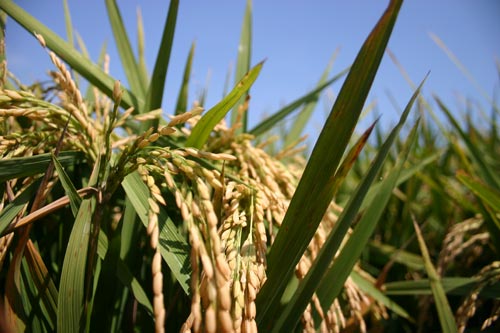
Unless you need Clearfield for red rice control, consider planting a conventional variety or at least rotate Clearfield and conventional rice in those fields.University of Arkansas' Flag the Technology program will help.Lack of diversity is causing problems with herbicide resistance in all crops.
March 9, 2011

It is almost planting time, and I hope everyone has decided what they will do. I would encourage you to communicate and even coordinate with your neighbors where conventional and Clearfield rice is planted. Likewise, I would encourage you to communicate your intentions to your aerial applicator.
I spend a lot of time in the field each season checking Newpath or Beyond drift complaints. Some are due to miscommunication and some are due to planting a Clearfield field in the middle of several conventional fields or vice versa. Most of these situations could be prevented.
A comment I heard last year was, “I am just going to plant 100 percent Clearfield rice to keep my neighbor from killing it.” I must admit that at the time I was looking at his field I couldn’t really argue with him. At the same time, unless you need the Clearfield technology for red rice control, I recommend that you plant a conventional variety or at least rotate Clearfield and conventional rice in those fields. That means we must have some resolution to the drift issue.
I also hear comments from frustrated applicators each year like, “Why did he plant that conventional field where he did and expect it not to be hit?” and “Why did he plant a Clearfield field where he did and expect me to be able to spray it?”
In addition to better verbal communication, I would strongly encourage you to participate in the University of Arkansas “Flag the Technology” program. Some companies are getting on board with this concept as well. In that program they have different colored “bicycle type” flags for Roundup Ready, LibertyLink, Clearfield and conventional weed control technologies.
The proper flags at field entrances can be great communicators. They can prevent an applicator from getting in the wrong field. They can prevent mistakes among workers on the farm. An applicator can make a quick drive around or fly around to see what is in neighboring fields.
Just as I am with Roundup Ready crops, I am a huge fan of the Clearfield rice technology. However, as we push the acreage closer and closer to 100 percent, we are going right down the same road we did with the Roundup Ready crops. A lot of this acreage is necessary.
Drift prevention should not be a reason to keep pushing the acreage up. Lack of diversity is causing major problems with herbicide resistance in all of our crops. We are putting unbelievable pressure on the ALS inhibiting herbicides in Clearfield rice with no good answers for what we will do when they blow up.
Some tell me they will just go back to what they were doing for red rice control before Clearfield came along. That sounds easy when you don’t have to do it yet. In addition, while red rice gets the major focus, barnyardgrass is the thousand-pound gorilla.
With the LibertyLink crops coming along, there are lots of opportunities to use them along with Roundup Ready, Clearfield and conventional crops to get more diversity into the cropping system.
While there are opportunities, they can present challenges. Everyone wants to keep their system as simple as possible. I understand that. The first year we had Roundup Ready soybeans in our research program at the University of Arkansas, I got some RR and conventional plots mixed up (don’t know until this day how I did it) and killed some plots. I knew how to solve the problem with more seed availability the next year — just plant all Roundup Ready soybeans!
However, the weeds have caught up with our lack of diversity, and programs will simply get more complicated. The farmer who stays ahead of the weeds the longest will be the one that learns to manage multiple technologies across crops on the farm. This means a step up in drift prevention and communication.
About the Author(s)
You May Also Like



